A Critical Analysis of Two Organizational Behaviour Theories: MGT5OBR
VerifiedAdded on 2022/12/26
|10
|2610
|1
Essay
AI Summary
This essay critically analyzes two key organizational behaviour theories: McClelland's theory of needs (achievement, power, and affiliation) and Maslow's hierarchy of needs (physiological, safety, belongingness, esteem, and self-actualization). The paper examines the core concepts of each theory, exploring how they explain employee motivation and behaviour within an organizational context. McClelland's theory focuses on the learned needs of employees, particularly those in higher positions, while Maslow's theory addresses a broader spectrum of needs from basic survival to self-fulfillment. The essay highlights the connections between the two theories, emphasizing how they can be used to understand and address employee needs at various levels. The analysis includes the application of these theories in the workplace, discussing how organizations can implement strategies to enhance employee satisfaction, motivation, and overall performance. The paper also acknowledges the limitations of each theory, providing a comprehensive overview of their relevance in modern organizational settings.
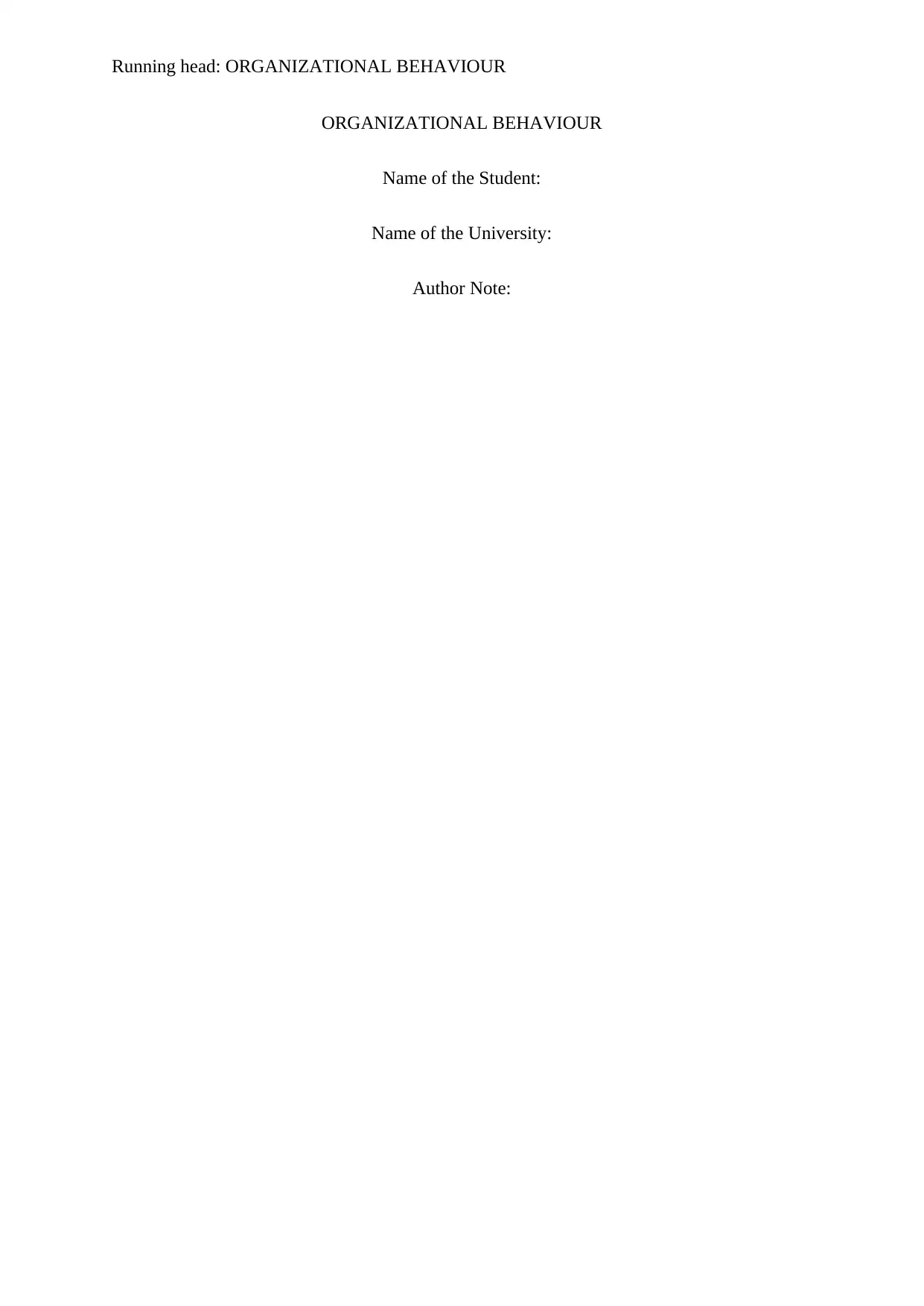
Running head: ORGANIZATIONAL BEHAVIOUR
ORGANIZATIONAL BEHAVIOUR
Name of the Student:
Name of the University:
Author Note:
ORGANIZATIONAL BEHAVIOUR
Name of the Student:
Name of the University:
Author Note:
Paraphrase This Document
Need a fresh take? Get an instant paraphrase of this document with our AI Paraphraser
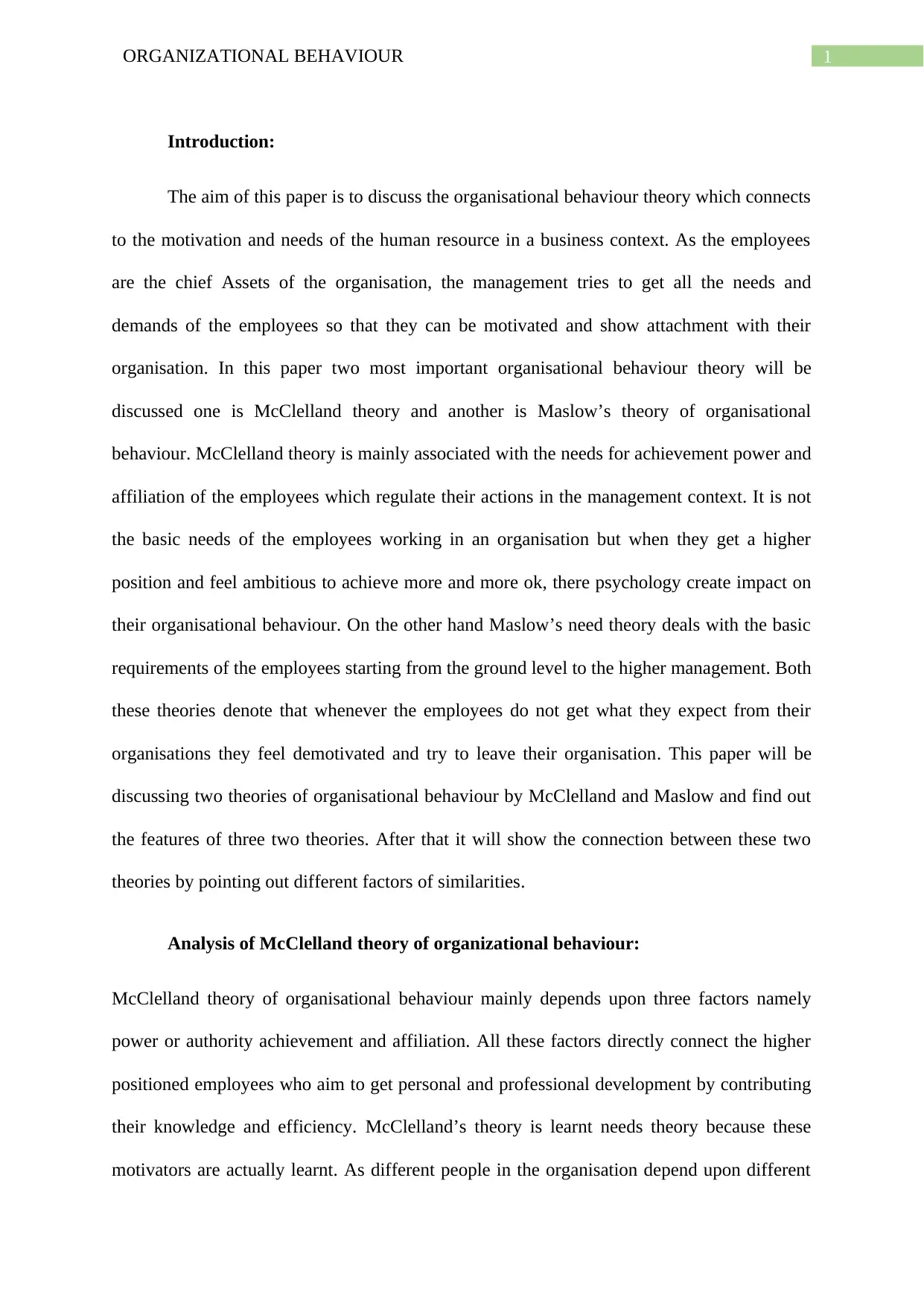
1ORGANIZATIONAL BEHAVIOUR
Introduction:
The aim of this paper is to discuss the organisational behaviour theory which connects
to the motivation and needs of the human resource in a business context. As the employees
are the chief Assets of the organisation, the management tries to get all the needs and
demands of the employees so that they can be motivated and show attachment with their
organisation. In this paper two most important organisational behaviour theory will be
discussed one is McClelland theory and another is Maslow’s theory of organisational
behaviour. McClelland theory is mainly associated with the needs for achievement power and
affiliation of the employees which regulate their actions in the management context. It is not
the basic needs of the employees working in an organisation but when they get a higher
position and feel ambitious to achieve more and more ok, there psychology create impact on
their organisational behaviour. On the other hand Maslow’s need theory deals with the basic
requirements of the employees starting from the ground level to the higher management. Both
these theories denote that whenever the employees do not get what they expect from their
organisations they feel demotivated and try to leave their organisation. This paper will be
discussing two theories of organisational behaviour by McClelland and Maslow and find out
the features of three two theories. After that it will show the connection between these two
theories by pointing out different factors of similarities.
Analysis of McClelland theory of organizational behaviour:
McClelland theory of organisational behaviour mainly depends upon three factors namely
power or authority achievement and affiliation. All these factors directly connect the higher
positioned employees who aim to get personal and professional development by contributing
their knowledge and efficiency. McClelland’s theory is learnt needs theory because these
motivators are actually learnt. As different people in the organisation depend upon different
Introduction:
The aim of this paper is to discuss the organisational behaviour theory which connects
to the motivation and needs of the human resource in a business context. As the employees
are the chief Assets of the organisation, the management tries to get all the needs and
demands of the employees so that they can be motivated and show attachment with their
organisation. In this paper two most important organisational behaviour theory will be
discussed one is McClelland theory and another is Maslow’s theory of organisational
behaviour. McClelland theory is mainly associated with the needs for achievement power and
affiliation of the employees which regulate their actions in the management context. It is not
the basic needs of the employees working in an organisation but when they get a higher
position and feel ambitious to achieve more and more ok, there psychology create impact on
their organisational behaviour. On the other hand Maslow’s need theory deals with the basic
requirements of the employees starting from the ground level to the higher management. Both
these theories denote that whenever the employees do not get what they expect from their
organisations they feel demotivated and try to leave their organisation. This paper will be
discussing two theories of organisational behaviour by McClelland and Maslow and find out
the features of three two theories. After that it will show the connection between these two
theories by pointing out different factors of similarities.
Analysis of McClelland theory of organizational behaviour:
McClelland theory of organisational behaviour mainly depends upon three factors namely
power or authority achievement and affiliation. All these factors directly connect the higher
positioned employees who aim to get personal and professional development by contributing
their knowledge and efficiency. McClelland’s theory is learnt needs theory because these
motivators are actually learnt. As different people in the organisation depend upon different
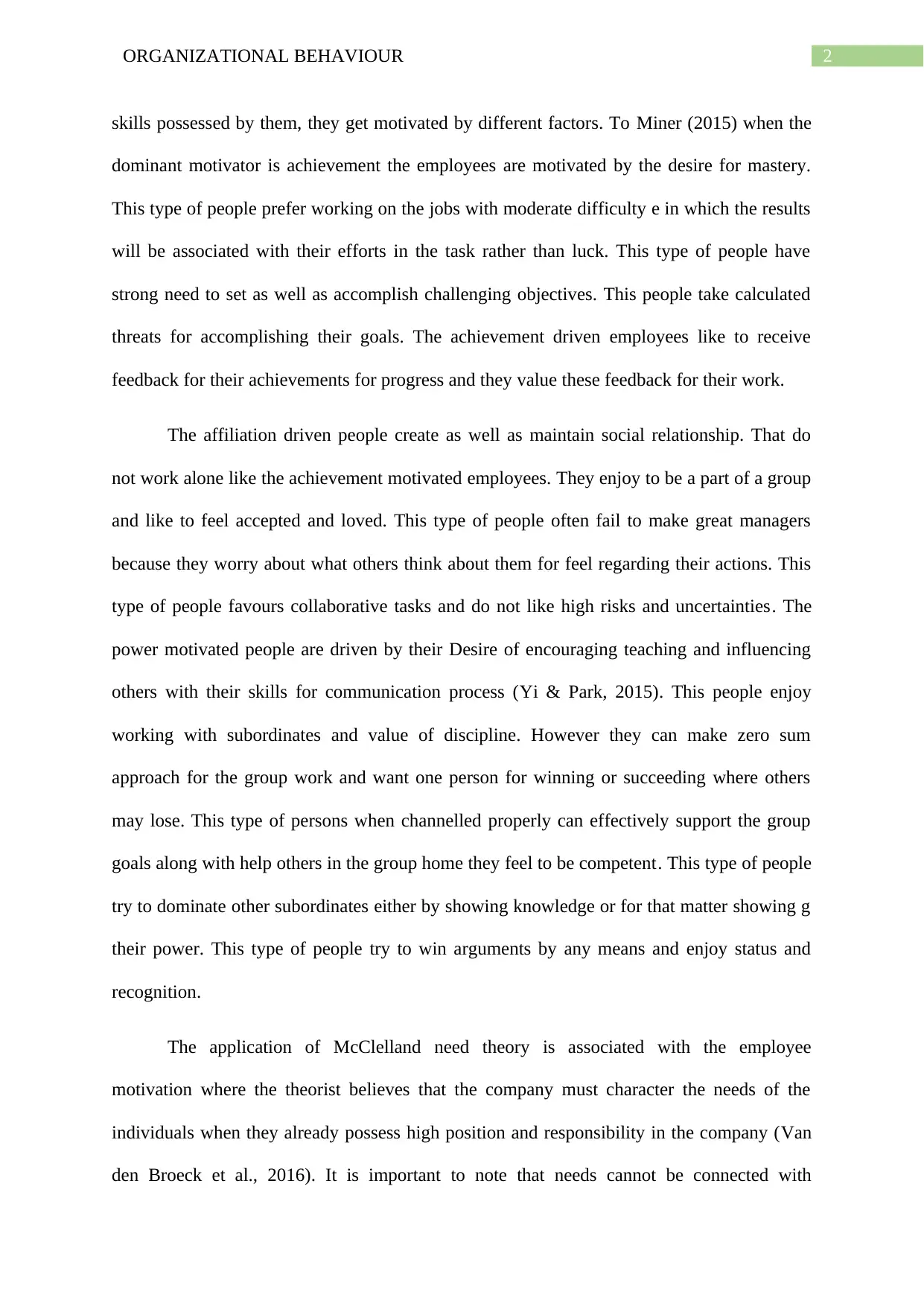
2ORGANIZATIONAL BEHAVIOUR
skills possessed by them, they get motivated by different factors. To Miner (2015) when the
dominant motivator is achievement the employees are motivated by the desire for mastery.
This type of people prefer working on the jobs with moderate difficulty e in which the results
will be associated with their efforts in the task rather than luck. This type of people have
strong need to set as well as accomplish challenging objectives. This people take calculated
threats for accomplishing their goals. The achievement driven employees like to receive
feedback for their achievements for progress and they value these feedback for their work.
The affiliation driven people create as well as maintain social relationship. That do
not work alone like the achievement motivated employees. They enjoy to be a part of a group
and like to feel accepted and loved. This type of people often fail to make great managers
because they worry about what others think about them for feel regarding their actions. This
type of people favours collaborative tasks and do not like high risks and uncertainties. The
power motivated people are driven by their Desire of encouraging teaching and influencing
others with their skills for communication process (Yi & Park, 2015). This people enjoy
working with subordinates and value of discipline. However they can make zero sum
approach for the group work and want one person for winning or succeeding where others
may lose. This type of persons when channelled properly can effectively support the group
goals along with help others in the group home they feel to be competent. This type of people
try to dominate other subordinates either by showing knowledge or for that matter showing g
their power. This type of people try to win arguments by any means and enjoy status and
recognition.
The application of McClelland need theory is associated with the employee
motivation where the theorist believes that the company must character the needs of the
individuals when they already possess high position and responsibility in the company (Van
den Broeck et al., 2016). It is important to note that needs cannot be connected with
skills possessed by them, they get motivated by different factors. To Miner (2015) when the
dominant motivator is achievement the employees are motivated by the desire for mastery.
This type of people prefer working on the jobs with moderate difficulty e in which the results
will be associated with their efforts in the task rather than luck. This type of people have
strong need to set as well as accomplish challenging objectives. This people take calculated
threats for accomplishing their goals. The achievement driven employees like to receive
feedback for their achievements for progress and they value these feedback for their work.
The affiliation driven people create as well as maintain social relationship. That do
not work alone like the achievement motivated employees. They enjoy to be a part of a group
and like to feel accepted and loved. This type of people often fail to make great managers
because they worry about what others think about them for feel regarding their actions. This
type of people favours collaborative tasks and do not like high risks and uncertainties. The
power motivated people are driven by their Desire of encouraging teaching and influencing
others with their skills for communication process (Yi & Park, 2015). This people enjoy
working with subordinates and value of discipline. However they can make zero sum
approach for the group work and want one person for winning or succeeding where others
may lose. This type of persons when channelled properly can effectively support the group
goals along with help others in the group home they feel to be competent. This type of people
try to dominate other subordinates either by showing knowledge or for that matter showing g
their power. This type of people try to win arguments by any means and enjoy status and
recognition.
The application of McClelland need theory is associated with the employee
motivation where the theorist believes that the company must character the needs of the
individuals when they already possess high position and responsibility in the company (Van
den Broeck et al., 2016). It is important to note that needs cannot be connected with
⊘ This is a preview!⊘
Do you want full access?
Subscribe today to unlock all pages.

Trusted by 1+ million students worldwide
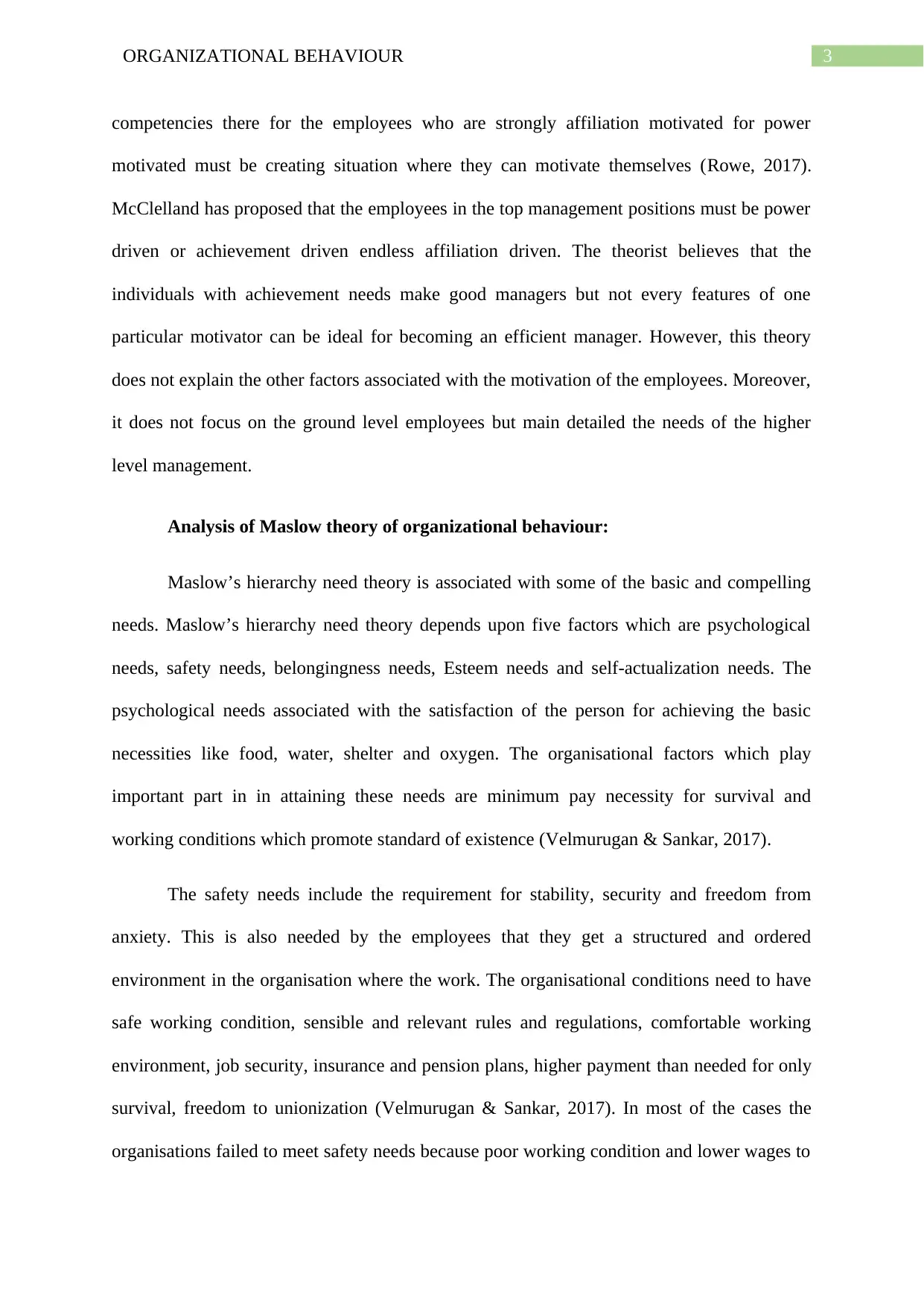
3ORGANIZATIONAL BEHAVIOUR
competencies there for the employees who are strongly affiliation motivated for power
motivated must be creating situation where they can motivate themselves (Rowe, 2017).
McClelland has proposed that the employees in the top management positions must be power
driven or achievement driven endless affiliation driven. The theorist believes that the
individuals with achievement needs make good managers but not every features of one
particular motivator can be ideal for becoming an efficient manager. However, this theory
does not explain the other factors associated with the motivation of the employees. Moreover,
it does not focus on the ground level employees but main detailed the needs of the higher
level management.
Analysis of Maslow theory of organizational behaviour:
Maslow’s hierarchy need theory is associated with some of the basic and compelling
needs. Maslow’s hierarchy need theory depends upon five factors which are psychological
needs, safety needs, belongingness needs, Esteem needs and self-actualization needs. The
psychological needs associated with the satisfaction of the person for achieving the basic
necessities like food, water, shelter and oxygen. The organisational factors which play
important part in in attaining these needs are minimum pay necessity for survival and
working conditions which promote standard of existence (Velmurugan & Sankar, 2017).
The safety needs include the requirement for stability, security and freedom from
anxiety. This is also needed by the employees that they get a structured and ordered
environment in the organisation where the work. The organisational conditions need to have
safe working condition, sensible and relevant rules and regulations, comfortable working
environment, job security, insurance and pension plans, higher payment than needed for only
survival, freedom to unionization (Velmurugan & Sankar, 2017). In most of the cases the
organisations failed to meet safety needs because poor working condition and lower wages to
competencies there for the employees who are strongly affiliation motivated for power
motivated must be creating situation where they can motivate themselves (Rowe, 2017).
McClelland has proposed that the employees in the top management positions must be power
driven or achievement driven endless affiliation driven. The theorist believes that the
individuals with achievement needs make good managers but not every features of one
particular motivator can be ideal for becoming an efficient manager. However, this theory
does not explain the other factors associated with the motivation of the employees. Moreover,
it does not focus on the ground level employees but main detailed the needs of the higher
level management.
Analysis of Maslow theory of organizational behaviour:
Maslow’s hierarchy need theory is associated with some of the basic and compelling
needs. Maslow’s hierarchy need theory depends upon five factors which are psychological
needs, safety needs, belongingness needs, Esteem needs and self-actualization needs. The
psychological needs associated with the satisfaction of the person for achieving the basic
necessities like food, water, shelter and oxygen. The organisational factors which play
important part in in attaining these needs are minimum pay necessity for survival and
working conditions which promote standard of existence (Velmurugan & Sankar, 2017).
The safety needs include the requirement for stability, security and freedom from
anxiety. This is also needed by the employees that they get a structured and ordered
environment in the organisation where the work. The organisational conditions need to have
safe working condition, sensible and relevant rules and regulations, comfortable working
environment, job security, insurance and pension plans, higher payment than needed for only
survival, freedom to unionization (Velmurugan & Sankar, 2017). In most of the cases the
organisations failed to meet safety needs because poor working condition and lower wages to
Paraphrase This Document
Need a fresh take? Get an instant paraphrase of this document with our AI Paraphraser
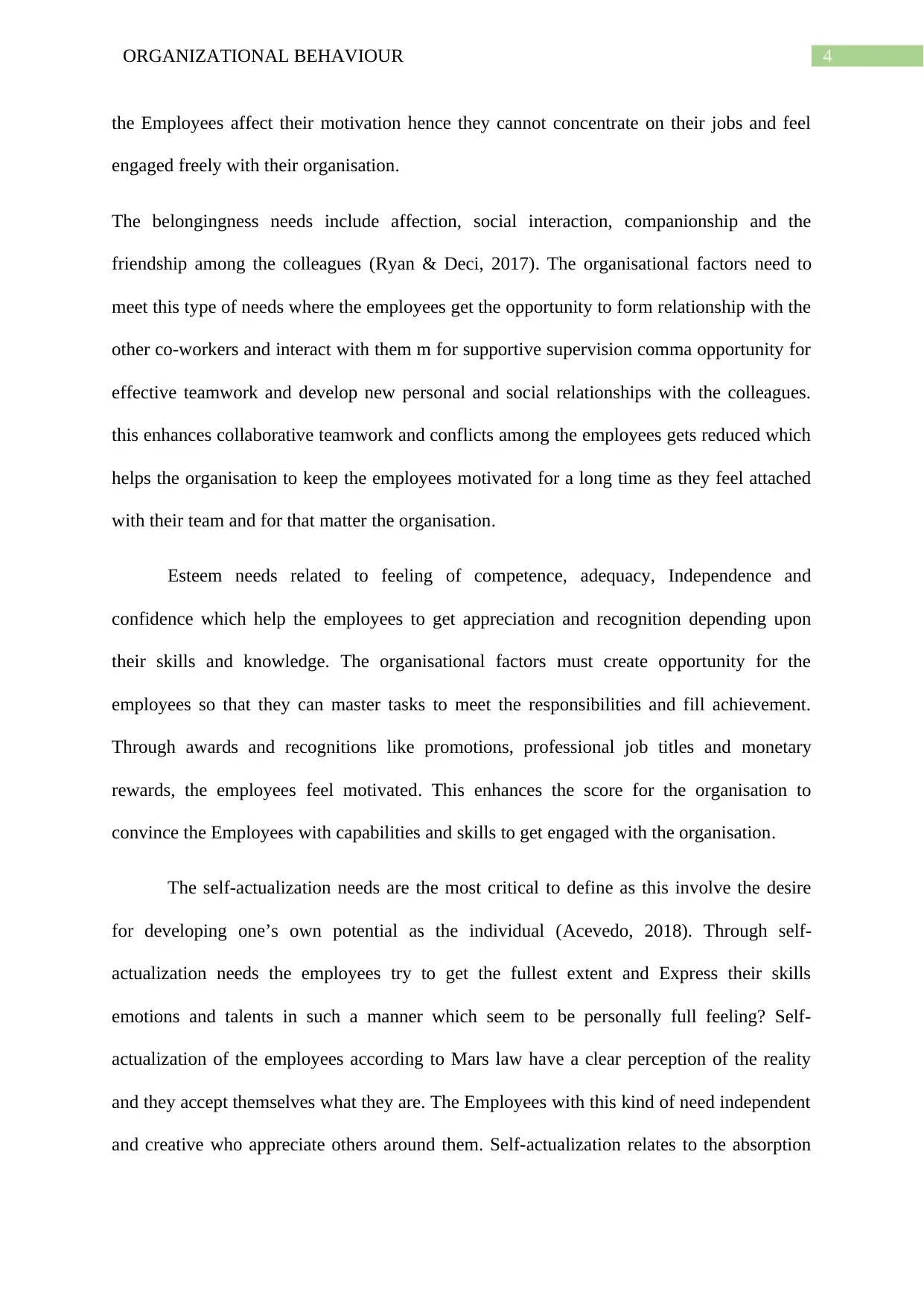
4ORGANIZATIONAL BEHAVIOUR
the Employees affect their motivation hence they cannot concentrate on their jobs and feel
engaged freely with their organisation.
The belongingness needs include affection, social interaction, companionship and the
friendship among the colleagues (Ryan & Deci, 2017). The organisational factors need to
meet this type of needs where the employees get the opportunity to form relationship with the
other co-workers and interact with them m for supportive supervision comma opportunity for
effective teamwork and develop new personal and social relationships with the colleagues.
this enhances collaborative teamwork and conflicts among the employees gets reduced which
helps the organisation to keep the employees motivated for a long time as they feel attached
with their team and for that matter the organisation.
Esteem needs related to feeling of competence, adequacy, Independence and
confidence which help the employees to get appreciation and recognition depending upon
their skills and knowledge. The organisational factors must create opportunity for the
employees so that they can master tasks to meet the responsibilities and fill achievement.
Through awards and recognitions like promotions, professional job titles and monetary
rewards, the employees feel motivated. This enhances the score for the organisation to
convince the Employees with capabilities and skills to get engaged with the organisation.
The self-actualization needs are the most critical to define as this involve the desire
for developing one’s own potential as the individual (Acevedo, 2018). Through self-
actualization needs the employees try to get the fullest extent and Express their skills
emotions and talents in such a manner which seem to be personally full feeling? Self-
actualization of the employees according to Mars law have a clear perception of the reality
and they accept themselves what they are. The Employees with this kind of need independent
and creative who appreciate others around them. Self-actualization relates to the absorption
the Employees affect their motivation hence they cannot concentrate on their jobs and feel
engaged freely with their organisation.
The belongingness needs include affection, social interaction, companionship and the
friendship among the colleagues (Ryan & Deci, 2017). The organisational factors need to
meet this type of needs where the employees get the opportunity to form relationship with the
other co-workers and interact with them m for supportive supervision comma opportunity for
effective teamwork and develop new personal and social relationships with the colleagues.
this enhances collaborative teamwork and conflicts among the employees gets reduced which
helps the organisation to keep the employees motivated for a long time as they feel attached
with their team and for that matter the organisation.
Esteem needs related to feeling of competence, adequacy, Independence and
confidence which help the employees to get appreciation and recognition depending upon
their skills and knowledge. The organisational factors must create opportunity for the
employees so that they can master tasks to meet the responsibilities and fill achievement.
Through awards and recognitions like promotions, professional job titles and monetary
rewards, the employees feel motivated. This enhances the score for the organisation to
convince the Employees with capabilities and skills to get engaged with the organisation.
The self-actualization needs are the most critical to define as this involve the desire
for developing one’s own potential as the individual (Acevedo, 2018). Through self-
actualization needs the employees try to get the fullest extent and Express their skills
emotions and talents in such a manner which seem to be personally full feeling? Self-
actualization of the employees according to Mars law have a clear perception of the reality
and they accept themselves what they are. The Employees with this kind of need independent
and creative who appreciate others around them. Self-actualization relates to the absorption
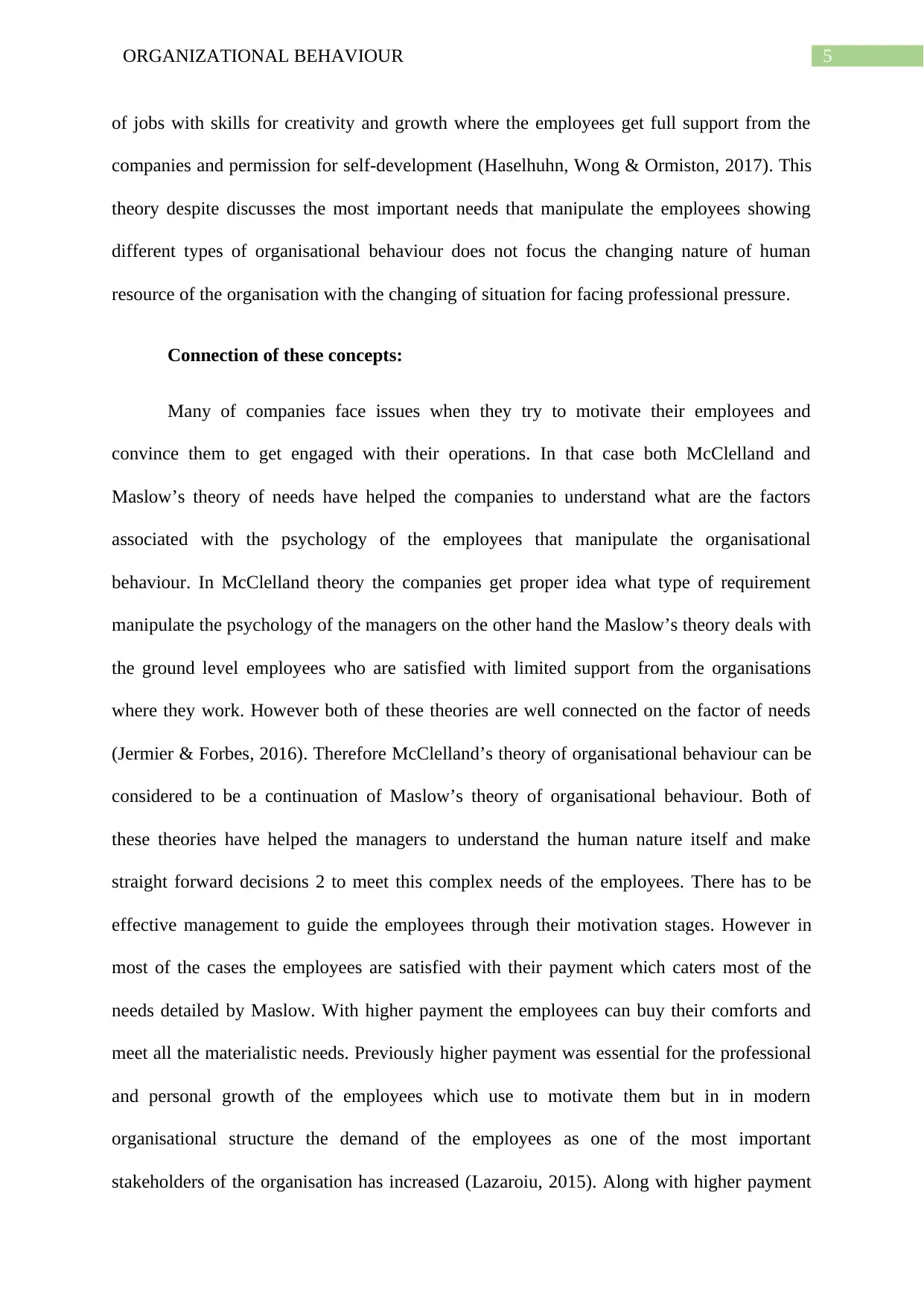
5ORGANIZATIONAL BEHAVIOUR
of jobs with skills for creativity and growth where the employees get full support from the
companies and permission for self-development (Haselhuhn, Wong & Ormiston, 2017). This
theory despite discusses the most important needs that manipulate the employees showing
different types of organisational behaviour does not focus the changing nature of human
resource of the organisation with the changing of situation for facing professional pressure.
Connection of these concepts:
Many of companies face issues when they try to motivate their employees and
convince them to get engaged with their operations. In that case both McClelland and
Maslow’s theory of needs have helped the companies to understand what are the factors
associated with the psychology of the employees that manipulate the organisational
behaviour. In McClelland theory the companies get proper idea what type of requirement
manipulate the psychology of the managers on the other hand the Maslow’s theory deals with
the ground level employees who are satisfied with limited support from the organisations
where they work. However both of these theories are well connected on the factor of needs
(Jermier & Forbes, 2016). Therefore McClelland’s theory of organisational behaviour can be
considered to be a continuation of Maslow’s theory of organisational behaviour. Both of
these theories have helped the managers to understand the human nature itself and make
straight forward decisions 2 to meet this complex needs of the employees. There has to be
effective management to guide the employees through their motivation stages. However in
most of the cases the employees are satisfied with their payment which caters most of the
needs detailed by Maslow. With higher payment the employees can buy their comforts and
meet all the materialistic needs. Previously higher payment was essential for the professional
and personal growth of the employees which use to motivate them but in in modern
organisational structure the demand of the employees as one of the most important
stakeholders of the organisation has increased (Lazaroiu, 2015). Along with higher payment
of jobs with skills for creativity and growth where the employees get full support from the
companies and permission for self-development (Haselhuhn, Wong & Ormiston, 2017). This
theory despite discusses the most important needs that manipulate the employees showing
different types of organisational behaviour does not focus the changing nature of human
resource of the organisation with the changing of situation for facing professional pressure.
Connection of these concepts:
Many of companies face issues when they try to motivate their employees and
convince them to get engaged with their operations. In that case both McClelland and
Maslow’s theory of needs have helped the companies to understand what are the factors
associated with the psychology of the employees that manipulate the organisational
behaviour. In McClelland theory the companies get proper idea what type of requirement
manipulate the psychology of the managers on the other hand the Maslow’s theory deals with
the ground level employees who are satisfied with limited support from the organisations
where they work. However both of these theories are well connected on the factor of needs
(Jermier & Forbes, 2016). Therefore McClelland’s theory of organisational behaviour can be
considered to be a continuation of Maslow’s theory of organisational behaviour. Both of
these theories have helped the managers to understand the human nature itself and make
straight forward decisions 2 to meet this complex needs of the employees. There has to be
effective management to guide the employees through their motivation stages. However in
most of the cases the employees are satisfied with their payment which caters most of the
needs detailed by Maslow. With higher payment the employees can buy their comforts and
meet all the materialistic needs. Previously higher payment was essential for the professional
and personal growth of the employees which use to motivate them but in in modern
organisational structure the demand of the employees as one of the most important
stakeholders of the organisation has increased (Lazaroiu, 2015). Along with higher payment
⊘ This is a preview!⊘
Do you want full access?
Subscribe today to unlock all pages.

Trusted by 1+ million students worldwide
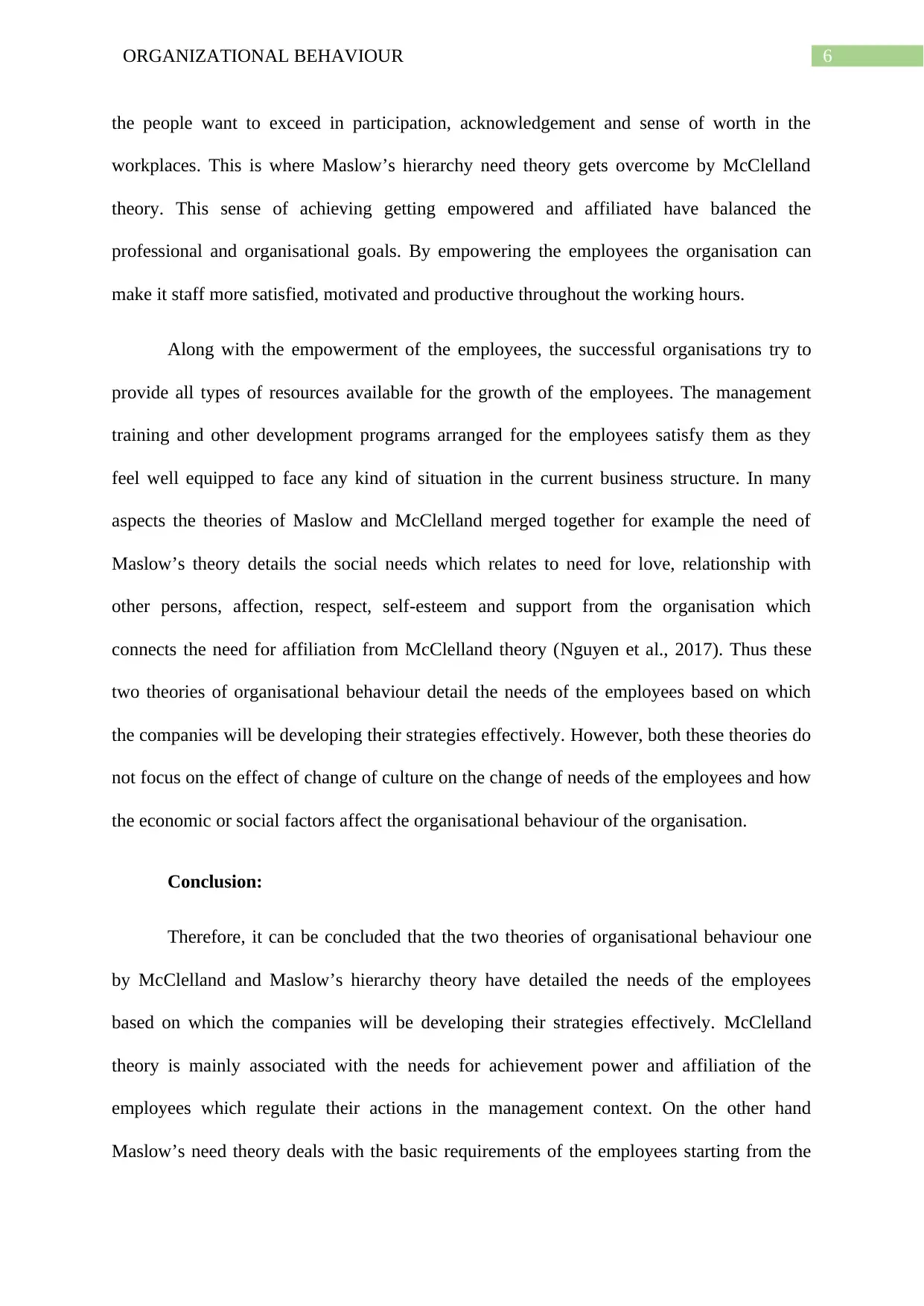
6ORGANIZATIONAL BEHAVIOUR
the people want to exceed in participation, acknowledgement and sense of worth in the
workplaces. This is where Maslow’s hierarchy need theory gets overcome by McClelland
theory. This sense of achieving getting empowered and affiliated have balanced the
professional and organisational goals. By empowering the employees the organisation can
make it staff more satisfied, motivated and productive throughout the working hours.
Along with the empowerment of the employees, the successful organisations try to
provide all types of resources available for the growth of the employees. The management
training and other development programs arranged for the employees satisfy them as they
feel well equipped to face any kind of situation in the current business structure. In many
aspects the theories of Maslow and McClelland merged together for example the need of
Maslow’s theory details the social needs which relates to need for love, relationship with
other persons, affection, respect, self-esteem and support from the organisation which
connects the need for affiliation from McClelland theory (Nguyen et al., 2017). Thus these
two theories of organisational behaviour detail the needs of the employees based on which
the companies will be developing their strategies effectively. However, both these theories do
not focus on the effect of change of culture on the change of needs of the employees and how
the economic or social factors affect the organisational behaviour of the organisation.
Conclusion:
Therefore, it can be concluded that the two theories of organisational behaviour one
by McClelland and Maslow’s hierarchy theory have detailed the needs of the employees
based on which the companies will be developing their strategies effectively. McClelland
theory is mainly associated with the needs for achievement power and affiliation of the
employees which regulate their actions in the management context. On the other hand
Maslow’s need theory deals with the basic requirements of the employees starting from the
the people want to exceed in participation, acknowledgement and sense of worth in the
workplaces. This is where Maslow’s hierarchy need theory gets overcome by McClelland
theory. This sense of achieving getting empowered and affiliated have balanced the
professional and organisational goals. By empowering the employees the organisation can
make it staff more satisfied, motivated and productive throughout the working hours.
Along with the empowerment of the employees, the successful organisations try to
provide all types of resources available for the growth of the employees. The management
training and other development programs arranged for the employees satisfy them as they
feel well equipped to face any kind of situation in the current business structure. In many
aspects the theories of Maslow and McClelland merged together for example the need of
Maslow’s theory details the social needs which relates to need for love, relationship with
other persons, affection, respect, self-esteem and support from the organisation which
connects the need for affiliation from McClelland theory (Nguyen et al., 2017). Thus these
two theories of organisational behaviour detail the needs of the employees based on which
the companies will be developing their strategies effectively. However, both these theories do
not focus on the effect of change of culture on the change of needs of the employees and how
the economic or social factors affect the organisational behaviour of the organisation.
Conclusion:
Therefore, it can be concluded that the two theories of organisational behaviour one
by McClelland and Maslow’s hierarchy theory have detailed the needs of the employees
based on which the companies will be developing their strategies effectively. McClelland
theory is mainly associated with the needs for achievement power and affiliation of the
employees which regulate their actions in the management context. On the other hand
Maslow’s need theory deals with the basic requirements of the employees starting from the
Paraphrase This Document
Need a fresh take? Get an instant paraphrase of this document with our AI Paraphraser
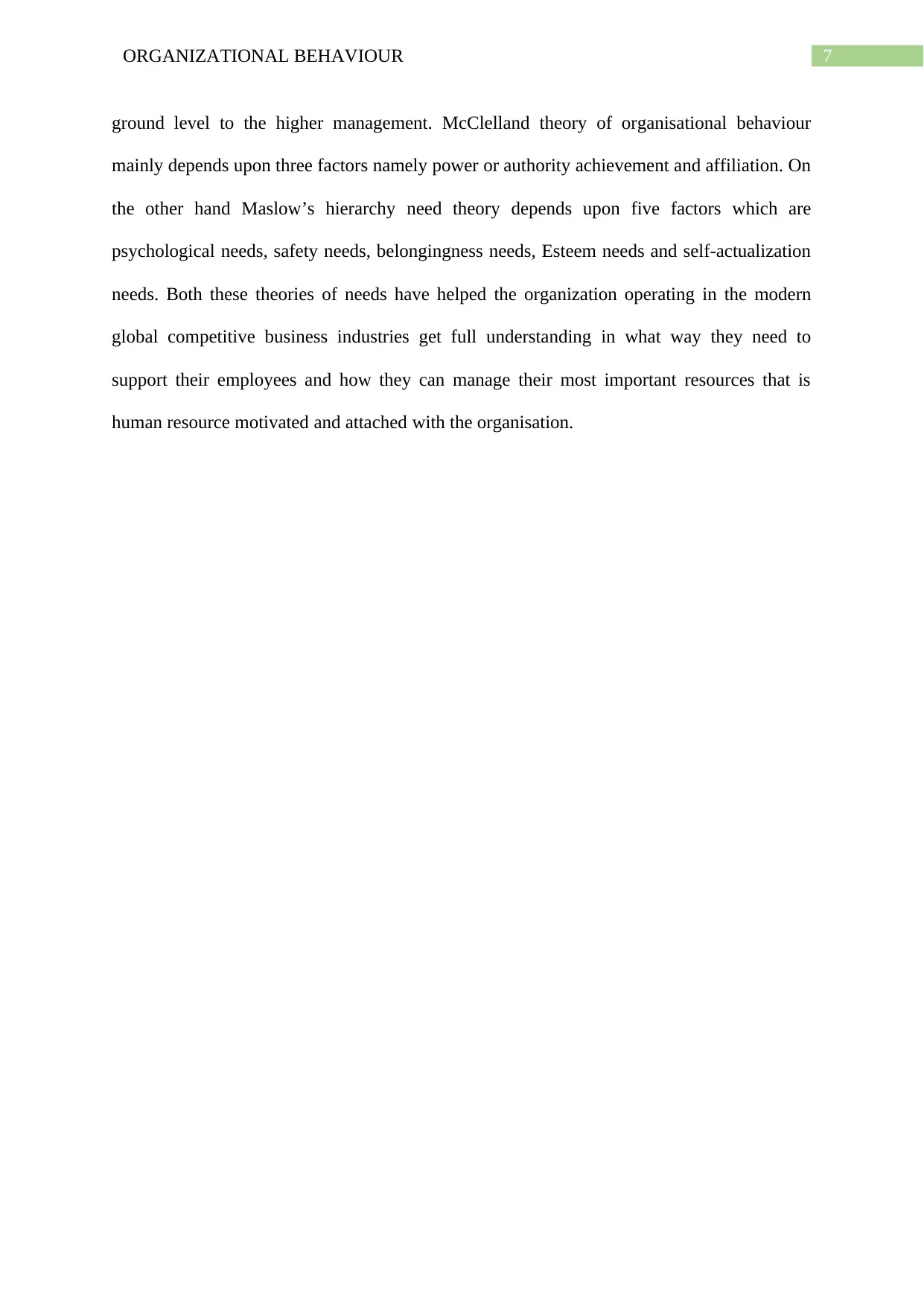
7ORGANIZATIONAL BEHAVIOUR
ground level to the higher management. McClelland theory of organisational behaviour
mainly depends upon three factors namely power or authority achievement and affiliation. On
the other hand Maslow’s hierarchy need theory depends upon five factors which are
psychological needs, safety needs, belongingness needs, Esteem needs and self-actualization
needs. Both these theories of needs have helped the organization operating in the modern
global competitive business industries get full understanding in what way they need to
support their employees and how they can manage their most important resources that is
human resource motivated and attached with the organisation.
ground level to the higher management. McClelland theory of organisational behaviour
mainly depends upon three factors namely power or authority achievement and affiliation. On
the other hand Maslow’s hierarchy need theory depends upon five factors which are
psychological needs, safety needs, belongingness needs, Esteem needs and self-actualization
needs. Both these theories of needs have helped the organization operating in the modern
global competitive business industries get full understanding in what way they need to
support their employees and how they can manage their most important resources that is
human resource motivated and attached with the organisation.
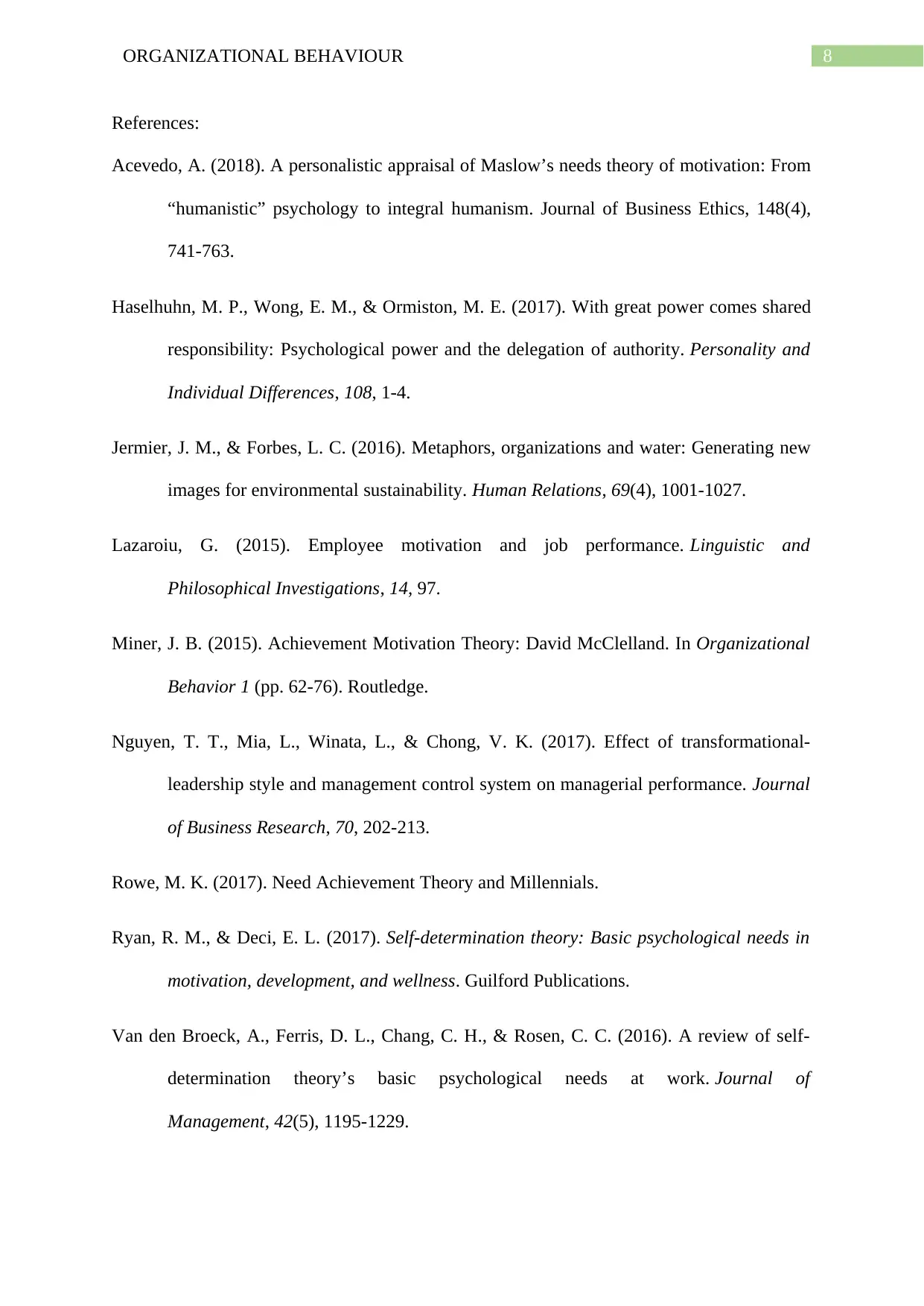
8ORGANIZATIONAL BEHAVIOUR
References:
Acevedo, A. (2018). A personalistic appraisal of Maslow’s needs theory of motivation: From
“humanistic” psychology to integral humanism. Journal of Business Ethics, 148(4),
741-763.
Haselhuhn, M. P., Wong, E. M., & Ormiston, M. E. (2017). With great power comes shared
responsibility: Psychological power and the delegation of authority. Personality and
Individual Differences, 108, 1-4.
Jermier, J. M., & Forbes, L. C. (2016). Metaphors, organizations and water: Generating new
images for environmental sustainability. Human Relations, 69(4), 1001-1027.
Lazaroiu, G. (2015). Employee motivation and job performance. Linguistic and
Philosophical Investigations, 14, 97.
Miner, J. B. (2015). Achievement Motivation Theory: David McClelland. In Organizational
Behavior 1 (pp. 62-76). Routledge.
Nguyen, T. T., Mia, L., Winata, L., & Chong, V. K. (2017). Effect of transformational-
leadership style and management control system on managerial performance. Journal
of Business Research, 70, 202-213.
Rowe, M. K. (2017). Need Achievement Theory and Millennials.
Ryan, R. M., & Deci, E. L. (2017). Self-determination theory: Basic psychological needs in
motivation, development, and wellness. Guilford Publications.
Van den Broeck, A., Ferris, D. L., Chang, C. H., & Rosen, C. C. (2016). A review of self-
determination theory’s basic psychological needs at work. Journal of
Management, 42(5), 1195-1229.
References:
Acevedo, A. (2018). A personalistic appraisal of Maslow’s needs theory of motivation: From
“humanistic” psychology to integral humanism. Journal of Business Ethics, 148(4),
741-763.
Haselhuhn, M. P., Wong, E. M., & Ormiston, M. E. (2017). With great power comes shared
responsibility: Psychological power and the delegation of authority. Personality and
Individual Differences, 108, 1-4.
Jermier, J. M., & Forbes, L. C. (2016). Metaphors, organizations and water: Generating new
images for environmental sustainability. Human Relations, 69(4), 1001-1027.
Lazaroiu, G. (2015). Employee motivation and job performance. Linguistic and
Philosophical Investigations, 14, 97.
Miner, J. B. (2015). Achievement Motivation Theory: David McClelland. In Organizational
Behavior 1 (pp. 62-76). Routledge.
Nguyen, T. T., Mia, L., Winata, L., & Chong, V. K. (2017). Effect of transformational-
leadership style and management control system on managerial performance. Journal
of Business Research, 70, 202-213.
Rowe, M. K. (2017). Need Achievement Theory and Millennials.
Ryan, R. M., & Deci, E. L. (2017). Self-determination theory: Basic psychological needs in
motivation, development, and wellness. Guilford Publications.
Van den Broeck, A., Ferris, D. L., Chang, C. H., & Rosen, C. C. (2016). A review of self-
determination theory’s basic psychological needs at work. Journal of
Management, 42(5), 1195-1229.
⊘ This is a preview!⊘
Do you want full access?
Subscribe today to unlock all pages.

Trusted by 1+ million students worldwide
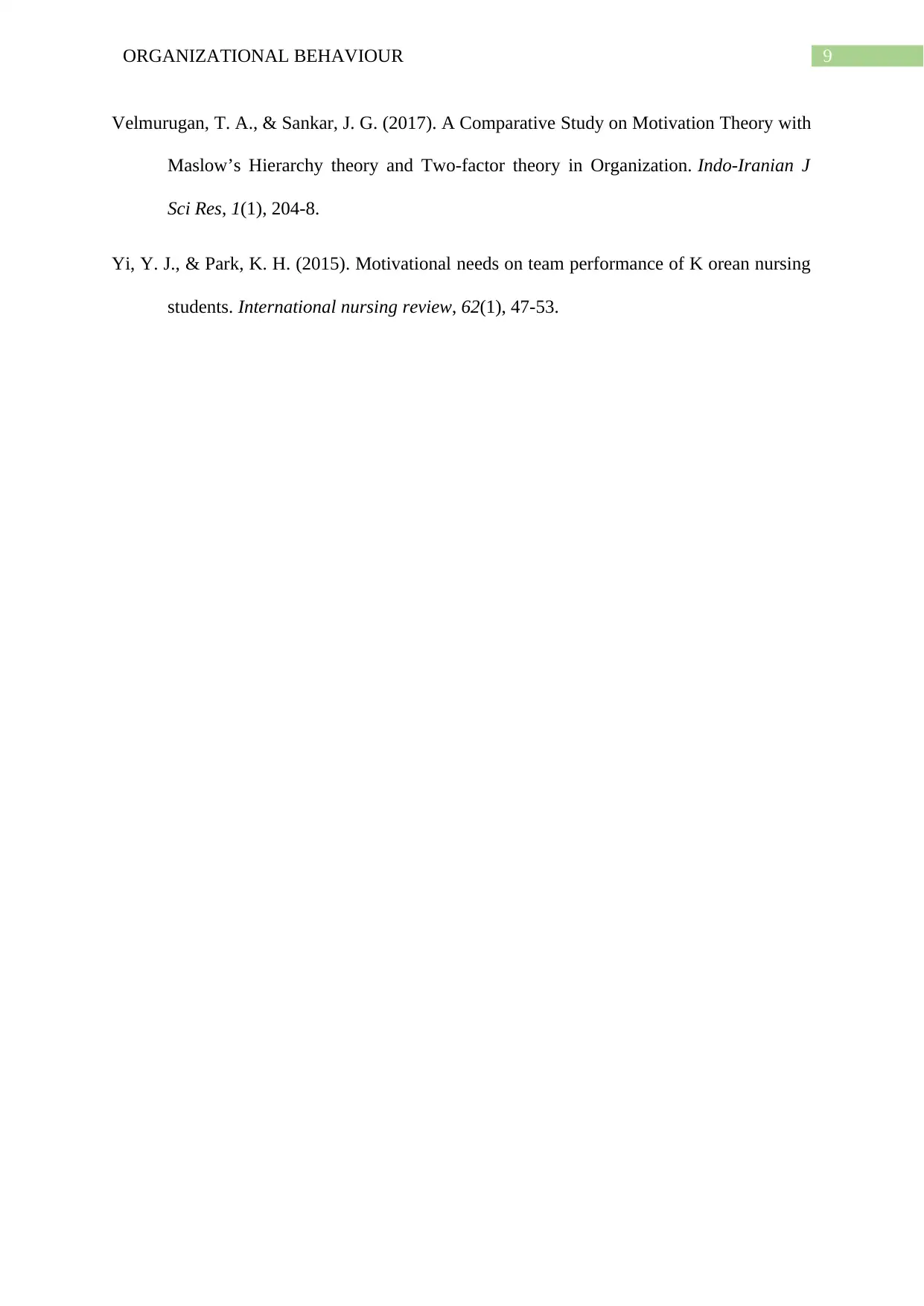
9ORGANIZATIONAL BEHAVIOUR
Velmurugan, T. A., & Sankar, J. G. (2017). A Comparative Study on Motivation Theory with
Maslow’s Hierarchy theory and Two-factor theory in Organization. Indo-Iranian J
Sci Res, 1(1), 204-8.
Yi, Y. J., & Park, K. H. (2015). Motivational needs on team performance of K orean nursing
students. International nursing review, 62(1), 47-53.
Velmurugan, T. A., & Sankar, J. G. (2017). A Comparative Study on Motivation Theory with
Maslow’s Hierarchy theory and Two-factor theory in Organization. Indo-Iranian J
Sci Res, 1(1), 204-8.
Yi, Y. J., & Park, K. H. (2015). Motivational needs on team performance of K orean nursing
students. International nursing review, 62(1), 47-53.
1 out of 10
Related Documents
Your All-in-One AI-Powered Toolkit for Academic Success.
+13062052269
info@desklib.com
Available 24*7 on WhatsApp / Email
![[object Object]](/_next/static/media/star-bottom.7253800d.svg)
Unlock your academic potential
Copyright © 2020–2025 A2Z Services. All Rights Reserved. Developed and managed by ZUCOL.



